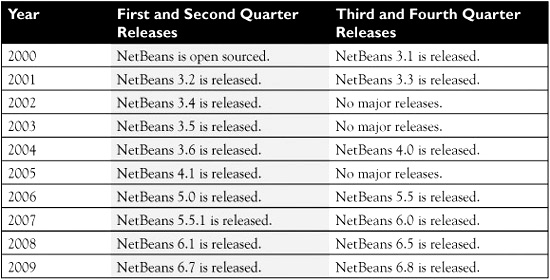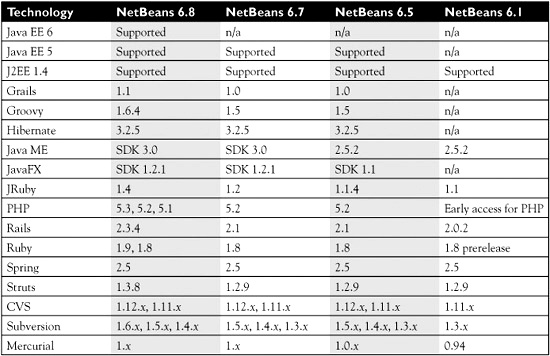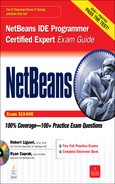A
NetBeans Versions
NetBeans IDE Versions
NetBeans has a long history in the Java community. It started as a student project in 1996 with its first prerelease in 1997. It was originally known as Xelfi prior to being renamed NetBeans in 1998. From the start it was written completely in Java and ran on all of the supported Java platforms—thus, it was true to the spirit of Java. In late 1999 Sun Microsystems acquired NetBeans. For a brief period NetBeans was renamed to Forte for Java. At the time Sun had also purchased Forte and integrated Forte’s tools into NetBeans. In the summer of 2000 Sun open-sourced NetBeans, and netbeans.org went public.
From 2004 to 2007 Sun Microsystems also released and supported commercial variants of NetBeans named Java Studio Creator and Java Studio Enterprise. These targeted corporate and enterprise developers, respectively. Both products were based on NetBeans and were accompanied with support contracts. Java Studio Creator attempted to lower the bar for novice developers. In 2007 Sun migrated customers to NetBeans. NetBeans had continued to evolve and was always a step ahead of the Sun Studio tools.
Here is the NetBeans timeline:

Each version of NetBeans adds new features and refines old ones. Sun—now Oracle—uses NetBeans to showcase and support new features added to the Java platform. For instance, NetBeans has been the leading environment for JavaFX.
Supported Technologies
This appendix focuses on the feature history of NetBeans 6.x (see Table A-1). Information on older releases and NetBeans press announcements can be found at http://netbeans.org/about/history.html.
TABLE A-1 Supported Technologies

Note, Java ME has not been available on all platforms. Also, the Java ME SDK 3.0 replaces Java Wireless Toolkit 2.5.2 and Java Toolkit 1.0 for CDC.
New Features
This section outlines the new features in each release of NetBeans back to version 6.1. It is important to note that over time the disparate development tools produced by Sun have been migrated to NetBeans to provide for a uniform development experience:
![]() JFluid is now the NetBeans Profiler.
JFluid is now the NetBeans Profiler.
![]() Sun Java Studio Mobility is now the Mobility Pack for NetBeans.
Sun Java Studio Mobility is now the Mobility Pack for NetBeans.
![]() Sun Java Studio Enterprise is now the Enterprise Pack.
Sun Java Studio Enterprise is now the Enterprise Pack.
![]() Sun Studio is now the C/C++ pack.
Sun Studio is now the C/C++ pack.
![]() Sun Java Studio Creator is now the Visual Web Pack. Note that the Visual Web Pack was removed from NetBeans as of version 6.7.
Sun Java Studio Creator is now the Visual Web Pack. Note that the Visual Web Pack was removed from NetBeans as of version 6.7.
More information on the packs can be found at: http://wiki.netbeans.org/wiki/images/5/53/NetBeansTOI_GreggSporar.pdf.
Since running NetBeans 6.x with every possible plugin and technology dramatically increases the IDE footprint, the Features on Demand initiative was implemented in NetBeans 6.7. This means that a base version of NetBeans can be downloaded—Java SE, for example—and features can be activated as necessary afterwards via the Plugin Manager. Thus, if a Java SE bundle is downloaded and installed, it isn’t necessary to download a different version of NetBeans.
To see where NetBeans is going in the future or to check out previous releases: http://netbeans.org/community/releases/roadmap.html.
NetBeans IDE 6.8 New Features
Official release summary: http://netbeans.org/community/releases/68/.
New features of NetBeans IDE 6.8 include support of the following items:
![]() C++ profiling Improved profiling with Microstate Accounting indicator and I/O usage monitor.
C++ profiling Improved profiling with Microstate Accounting indicator and I/O usage monitor.
![]() GlassFish v3 Support for the GlassFish version 3 application server: https://glassfish.dev.java.net/.
GlassFish v3 Support for the GlassFish version 3 application server: https://glassfish.dev.java.net/.
![]() Grails Support for Grails 1.1: http://www.grails.org.
Grails Support for Grails 1.1: http://www.grails.org.
![]() Groovy Support for Groovy 1.6.4: http://groovy.codehaus.org.
Groovy Support for Groovy 1.6.4: http://groovy.codehaus.org.
![]() Java Enterprise Edition 6 This includes the Java EE 6 web profiles, EJB 3.1, JAX-WS 2.2, and JAXB 2.2 implementations.
Java Enterprise Edition 6 This includes the Java EE 6 web profiles, EJB 3.1, JAX-WS 2.2, and JAXB 2.2 implementations.
![]() Java Server Faces 2.0 Support for JSF 2.0 (JSR 314) and Facelets (https://facelets.dev.java.net/).
Java Server Faces 2.0 Support for JSF 2.0 (JSR 314) and Facelets (https://facelets.dev.java.net/).
![]() JavaFX SDK SDK was upgraded to 1.2.1.
JavaFX SDK SDK was upgraded to 1.2.1.
![]() JIRA Support for bug tracking: http://www.atlassian.com/software/jira.
JIRA Support for bug tracking: http://www.atlassian.com/software/jira.
![]() JRuby Support for JRuby 1.4: http://jruby.org.
JRuby Support for JRuby 1.4: http://jruby.org.
![]() PHP Support for PHP 5.3: http://php.net/releases/5_3_0.php.
PHP Support for PHP 5.3: http://php.net/releases/5_3_0.php.
![]() Rails Support for Rails 2.3.4.
Rails Support for Rails 2.3.4.
![]() Ruby Support for Ruby 1.9: http://www.ruby-lang.org.
Ruby Support for Ruby 1.9: http://www.ruby-lang.org.
![]() Struts Support for Struts 1.3.8: http://struts.apache.org.
Struts Support for Struts 1.3.8: http://struts.apache.org.
![]() Symfony Framework Support for the Symfony Open-Source PHP Web Framework: http://www.symfony-project.org.
Symfony Framework Support for the Symfony Open-Source PHP Web Framework: http://www.symfony-project.org.
NetBeans IDE 6.7/6.7.1 New Features
Official release summary: http://netbeans.org/community/releases/67/.
New features of NetBeans IDE 6.7.1 include support of the following items:
![]() C++ Support for code refactoring, profiling (DLight), the Qt library, and macro expansion.
C++ Support for code refactoring, profiling (DLight), the Qt library, and macro expansion.
![]() Java ME Java ME SDK 3.0 was bundled. Support was added for the Java Card Platform 3.0. Improvements were made to the SVG editor.
Java ME Java ME SDK 3.0 was bundled. Support was added for the Java Card Platform 3.0. Improvements were made to the SVG editor.
![]() JavaFX Live preview was added along with enhanced editor support.
JavaFX Live preview was added along with enhanced editor support.
![]() JRuby Support for JRuby 1.2.
JRuby Support for JRuby 1.2.
![]() Kenai Support for integrating with Kenai-hosted projects. Kenai is now end-of-life.
Kenai Support for integrating with Kenai-hosted projects. Kenai is now end-of-life.
![]() Maven Support for POM, the creation of plugins, and web services. Library dependency graph viewer was added.
Maven Support for POM, the creation of plugins, and web services. Library dependency graph viewer was added.
![]() PHP Support for Selenium and SQL code completion. PHPUnit support was added, and the editor gained SQL code completion.
PHP Support for Selenium and SQL code completion. PHPUnit support was added, and the editor gained SQL code completion.
![]() Profiler Support for exporting profiler data to CSV, HTML, and XML file formats was added. HeapWalker gained support for OQL queries.
Profiler Support for exporting profiler data to CSV, HTML, and XML file formats was added. HeapWalker gained support for OQL queries.
NetBeans IDE 6.5/6.5.1 New Features
Official release summary: http://netbeans.org/community/releases/65/.
New features of NetBeans IDE 6.5.1 include support of the following items:
![]() Compile and Deploy Support for the automatic compilation and deployment on Save for Java and Java EE applications.
Compile and Deploy Support for the automatic compilation and deployment on Save for Java and Java EE applications.
![]() Database Improved support including SQL history, SQL completion, and results viewing as well as editing improvements.
Database Improved support including SQL history, SQL completion, and results viewing as well as editing improvements.
![]() Grails Support for Grails 1.0.
Grails Support for Grails 1.0.
![]() Groovy Support for Groovy 1.5.
Groovy Support for Groovy 1.5.
![]() GUI Builder Support for Nimbus and simple class names.
GUI Builder Support for Nimbus and simple class names.
![]() Java Debugger The debugger was rewritten with a new user interface. Deadlock detection was added with a visual indicator.
Java Debugger The debugger was rewritten with a new user interface. Deadlock detection was added with a visual indicator.
![]() Java EE 5 Support for all of the APIs implemented against the Java Enterprise Edition 5 specification.
Java EE 5 Support for all of the APIs implemented against the Java Enterprise Edition 5 specification.
![]() Java ME Support for Java ME including Data Binding, SVG, and Custom Component creation. Code obfuscation was upgraded to ProGuard 4.2 and the test framework to JMUnit 1.1.0.
Java ME Support for Java ME including Data Binding, SVG, and Custom Component creation. Code obfuscation was upgraded to ProGuard 4.2 and the test framework to JMUnit 1.1.0.
![]() JavaFX Support for SDK 1.1. Includes support for animation, graphics, and media codecs for rich content application development for desktop and mobile devices.
JavaFX Support for SDK 1.1. Includes support for animation, graphics, and media codecs for rich content application development for desktop and mobile devices.
![]() Java SE Support was added for analyzing Javadoc as well as improved Eclipse project import and synchronization.
Java SE Support was added for analyzing Javadoc as well as improved Eclipse project import and synchronization.
![]() JavaScript/AJAX Support for debugging JavaScript was added along with HTTP transaction monitoring. JavaScript Library Manager was enhanced.
JavaScript/AJAX Support for debugging JavaScript was added along with HTTP transaction monitoring. JavaScript Library Manager was enhanced.
![]() JUnit Support for a single test method.
JUnit Support for a single test method.
![]() PHP Support for code completion, Xdebug, and web service features.
PHP Support for code completion, Xdebug, and web service features.
![]() Ruby Improved JavaScript, AJAX, and Ruby support.
Ruby Improved JavaScript, AJAX, and Ruby support.
NetBeans IDE 6.1 New Features
Official release summary: http://netbeans.org/community/releases/61/.
New features of NetBeans IDE 6.1 include support of the following items:
![]() Axis2 Support for Axis2 web services.
Axis2 Support for Axis2 web services.
![]() Inspect Members and Hierarchy Windows Inspect Members and Hierarchy actions now work when the caret in the Java Editor is on a Java class for which there is no source available.
Inspect Members and Hierarchy Windows Inspect Members and Hierarchy actions now work when the caret in the Java Editor is on a Java class for which there is no source available.
![]() JavaBeans Support for JavaBeans including view capability of Java Bean patterns in the Navigator and BeanInfo Editor.
JavaBeans Support for JavaBeans including view capability of Java Bean patterns in the Navigator and BeanInfo Editor.
![]() Javadoc and Sources Association Any JAR item on the project classpath can be associated with its Javadoc and sources, too.
Javadoc and Sources Association Any JAR item on the project classpath can be associated with its Javadoc and sources, too.
![]() Javadoc Code Completion Editing of Javadoc comments is more convenient with code completion.
Javadoc Code Completion Editing of Javadoc comments is more convenient with code completion.
![]() JavaScript Support for highlighting, refactoring, and code completion was added.
JavaScript Support for highlighting, refactoring, and code completion was added.
![]() Java ME MIDP emulation support was added for Mac OS X (Update Center). SVN Composer was also added.
Java ME MIDP emulation support was added for Mac OS X (Update Center). SVN Composer was also added.
![]() JSF CRUD Generator Allows generation of JavaServer Faces CRUD applications from JPA entity classes.
JSF CRUD Generator Allows generation of JavaServer Faces CRUD applications from JPA entity classes.
![]() MySQL New support in Database Explorer allowing for registration of MySQL servers, viewing/creating/deleting databases, creating and opening connections to these databases, and launching the administration tool for MySQL.
MySQL New support in Database Explorer allowing for registration of MySQL servers, viewing/creating/deleting databases, creating and opening connections to these databases, and launching the administration tool for MySQL.
![]() Performance The IDE now starts 40 percent faster. Memory consumption was reduced.
Performance The IDE now starts 40 percent faster. Memory consumption was reduced.
![]() Project Sharing This is a new feature in Java SE, Java Web, and all Java EE projects to be shared and built unattended. Relative path support was added for dependencies.
Project Sharing This is a new feature in Java SE, Java Web, and all Java EE projects to be shared and built unattended. Relative path support was added for dependencies.
![]() Spring Framework Support was added for Spring 2.5 (http://www.springsource.com), which includes Web MVC framework, code completion, and so on.
Spring Framework Support was added for Spring 2.5 (http://www.springsource.com), which includes Web MVC framework, code completion, and so on.
![]() Visual Web JSF Support for On Demand Binding Attribute in Visual Web JSF projects.
Visual Web JSF Support for On Demand Binding Attribute in Visual Web JSF projects.
![]() Web APIs Support for web APIs such as Amazon, Facebook, Google, Twitter, and Zillow were added.
Web APIs Support for web APIs such as Amazon, Facebook, Google, Twitter, and Zillow were added.
![]() Web services Support for restful web services was added (JSR 311).
Web services Support for restful web services was added (JSR 311).
![]() Window transparency Existing infrastructure has been enhanced to support window transparency (on platforms that provide it).
Window transparency Existing infrastructure has been enhanced to support window transparency (on platforms that provide it).
